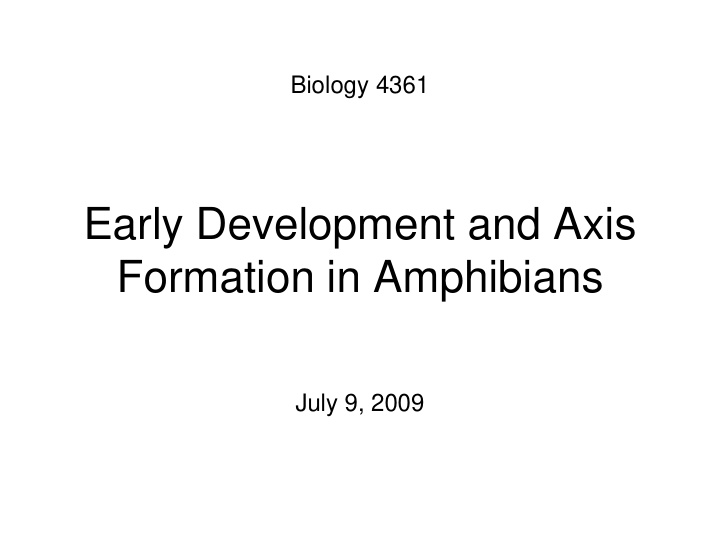



Biology 4361 Early Development and Axis Formation in Amphibians July 9, 2009
The Amphibian Model Common vertebrate (e.g. Rana , Xenopus ) Manipulable, observable (i.e. large eggs and embryos) 1) How are the body axes established? - How do relatively homogeneous cells (i.e. zygotes) establish polarity (complexity from simplicity)? 2) How are the germ layers determined? - How do zygotes send their cellular progeny (i.e. blastomeres) down pathways toward different fates? 3) How is development organized in a regulative system?
Amphibian Development - Overview Fertilization, cortical rotation Cleavage Gastrulation Axis and germ layer determination The “Organizer” Inductions: Mesoderm Dorsal/organizer Ectoderm Axes Summary (Photo by Harland lab/UC Berkeley) Left – Right Asymmetry
Cortical Rotation Fertilization – animal hemisphere Microtubular network originates at fertilization point
Holobl blas asti tic (complete ete cleav avage) age) Spec ecies es Cleavage age Yolk echinoderms, Radial clas assificati ation on Cleavage Patterns amphioxis annelids, molluscs, Spiral flatworms Isolecithal tunicates Bilateral mammals, nematode Rotational amphibians Displaced Mesolecithal radial Merobl blas asti tic (incom ompl plete ete cleav avage) age) cephalopod molluscs Bilateral Telolecithal fish, reptiles, birds Discoidal Centrolethical most insects Superficial
Unequal Radial Holoblastic Cleavage Cell cycles regulated by mitosis-promoting factor (MPF) - no G phases … until mid-blastula blastula transi nsition tion - promoters demethylated (i.e. de-repressed) - transcription factors formed in vegetal cytoplasm - embryonic control of development
Mechanics of Gastrulation Formation of the dorsal lip - vegetal rotation - invagination of bottle cells - involution of marginal zone cells Involuting Marginal Zone
Mechanics of Gastrulation - 2 motive force (D)
Xenopus Gastrulation
Cell Movements during Gastrulation Movements - invagination - involution - epiboly (animal cap) - intercalation and convergent extension - migration
Xenopus Gastrulation
Xenopus Gastrulation - Blastopore NIMZ
Amphibian Development - Overview Fertilization, cortical rotation Cleavage Gastrulation Axis and germ layer determination The “Organizer” Inductions: Mesoderm Dorsal/organizer Ectoderm Axes Summary (Photo by Harland lab/UC Berkeley)
Determination of Amphibian Axes If one blastomere received no gray crescent material, resulted in - “ belly piece ” – blood, mesenchyme, gut cells - no dorsal structures (e.g. notochord, somites) 2-cell stage The gray crescent area is critical for proper development Gray crescent = future dors rsal lip of th the blast stopo opore
Dorsal Lip Transplant (Spemann, Mangold experiment) Doral l lip = “ Organiz izer er ” - organizes secondary D-V axis - induced ventral cells to change fates
Amphibian Development - Overview Fertilization, cortical rotation Cleavage Gastrulation Axis and germ layer determination The “Organizer” Inductions: Mesoderm Dorsal/organizer Ectoderm Axes Summary (Photo by Harland lab/UC Berkeley) Left – Right Asymmetry
The Organizer Transplantation experiments established the organizing properties of the dorsal l blast stopo opore e lip, which … 1) Self-differentiates (all other tissues conditionally specified) 2) Establishes the dorsal-ventral axis 3) Specifies multiple tissues, including … - dorsal mesoderm, which includes … - head mesoderm (prechordal plate) - chordamesoderm (notochord) 4) Dorsalizes surrounding mesoderm into paraxial mesoderm 5) Induces the neural tube 6) Initiates the movements of gastrulation How is the dorsal al lip specifi ified ed?
Dorsal Signal: β -Catenin β -cate ateni nin nuclear transcription factor (in Wnt pathway) (in sea urchins, specifies micromeres, endomesoderm) (in Xenopus , specifies dorsal structures; e.g. organizer) β -catenin is initially distributed throughout the embryo, - accumulates only in prospective dorsal cells. - concentrated in the Nieuwkoop center and organizer Organizer Dorsalization of β -catenin: a) protect β -catenin in dorsal area, b) degrade β -catenin everywhere else. β -catenin Mechanism - cortical rotation … Nieuwkoop center
Disheveled/ β -Catenin/Cortical Rotation β -catenin induces cells to dorsal fates β -ca caten enin in is initially distributed throughout the oocyte Glyc ycoge ogen n synt nthase hase kinase ase 3 (GSK3) is also distributed throughout oocyte GSK3 marks β -catenin for degradation Dish shevel evelled led (Dsh Dsh) blocks GSK3 activity Dsh localizes in the cytoplasmic cortex at the vegetal pole
Disheveled/ β -Catenin/Cortical Rotation β -ca caten enin in, GSK3 distributed throughout Dish shevel evelled led - blocks GSK3-mediated β -catenin degradation - anywhere Dsh exists, β -catenin survives Dsh – Dishevelled Dsh GBP – GSK3 binding protein Kines esin in - motor protein
Disheveled/GSK3/ β -Catenin At the blastula stage, β -catenin is located exclusively in the future dorsal region GSK3 mediates β -catenin destruction …… but Disheveled and GBP block GSK3; - resulting in β -catenin present only in the marginal area opposite the point of sperm entry (i.e. future dorsal lip)
Organizer Induction β -catenin acts with Tcf3 (transcription factor); stimulates expression of dorsalizing genes: Siamois mois – TF; activates Xlim , goosecoid (dorsal determinants) Goosecoid ecoid protein – TF responsible for organizer properties Goosecoid also plays a part in specifying dorsal al me mesoderm erm; however, additional vegetal factors are needed: e.g. Vegeta etal l TGF- β signals als
Mesoderm/Organizer Induction VegT, Vg1, Xnr(s) (s) – Xenopu pus nodal dal relat ated ed genes; es; TGF- β family (early gastrulation) (mid-blastula) (late blastula) , dorsal and lateral mesoderm - somites, notochord & intermediate - mesenchyme, blood muscle, kidney
Determination of Ectoderm Early gastrulation stage cells are uncommitted - exhibit regulative development Later gastrula cells are determined - exhibit autonomous development
Establishment of Axes - Summary D-V axis – set up at fertilization A-P axis – established by gastrulation movements across the dorsal lip of the blastopore L-R axis – Nodal expression on Left, not Right
Left – Right Asymmetry wild-type Xnr1 -/- Left – Right axis established by Xenopus nodal-related (Xnr1) Nodal al expression: - common to all vertebrates - expressed on the left side! e! Xnr1 expression is limited to the left side in a process involving cortical rotation and Vg1 Block Xnr1 expression = random gut coiling, heart loops to the left heart looping gut coiling – counter-clockwise
Recommend
More recommend